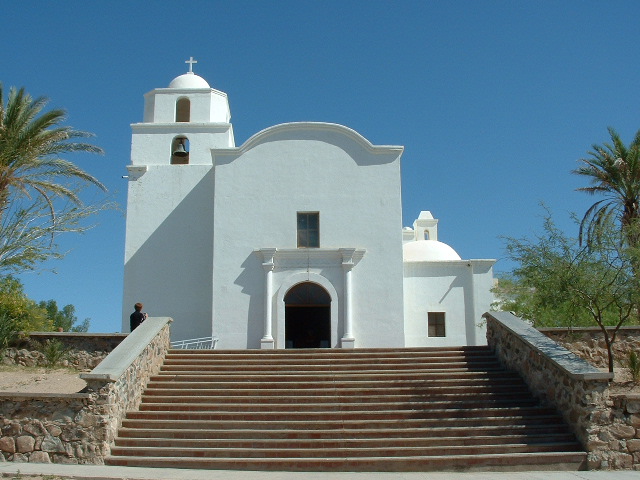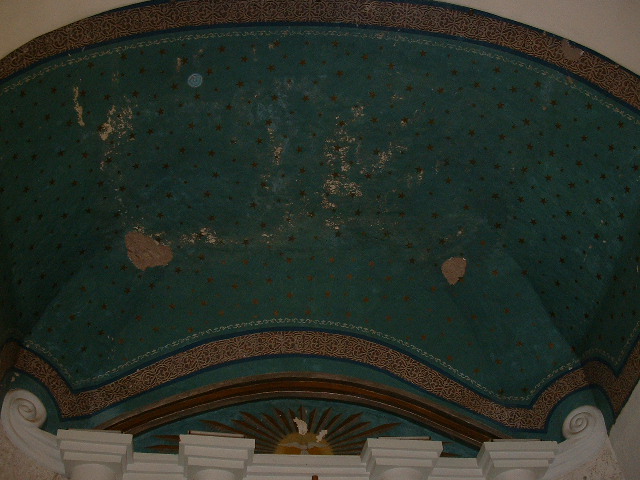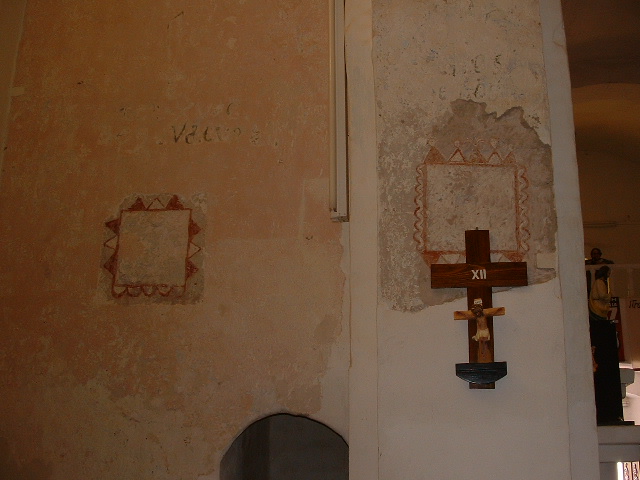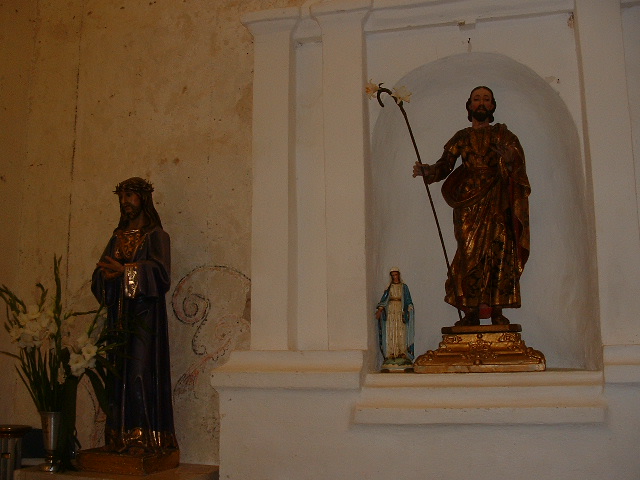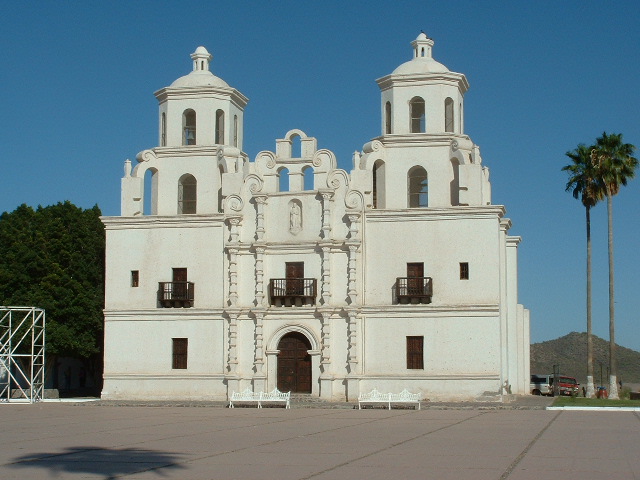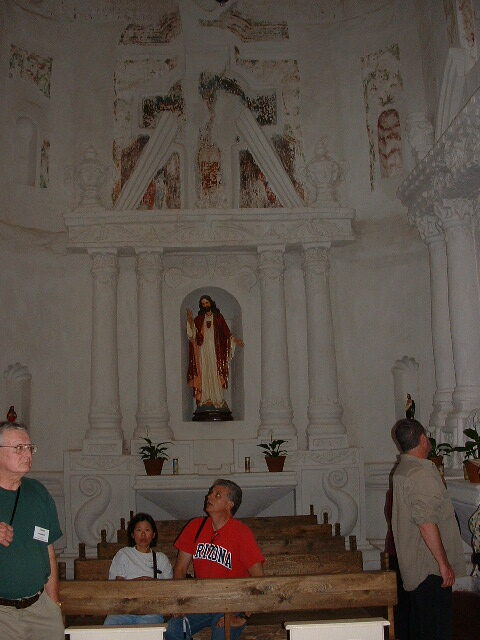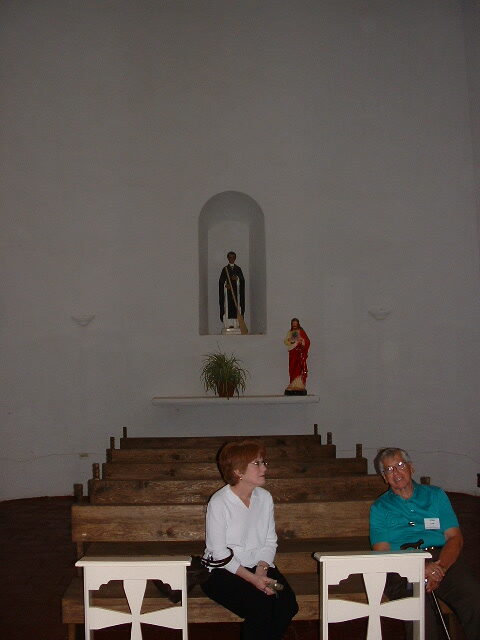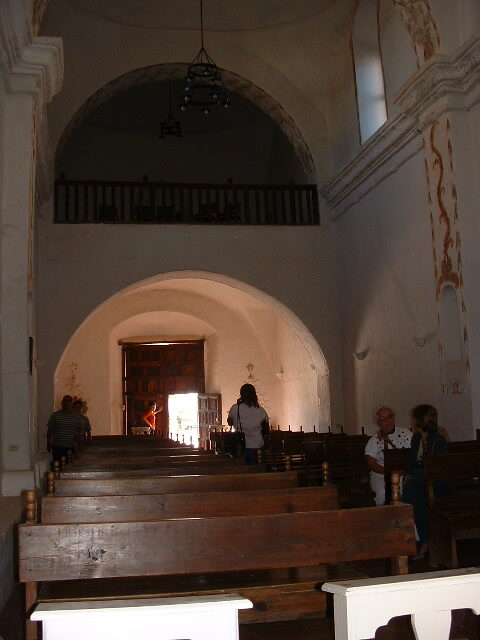Please be sure to read Parts One and Two of this story before proceeding with this one.
I find, as I continue to tell you about the stops we made at the various missions, that there is more to say than I thought there would be. Each of them has such a long history filled with interesting details – I only wish I had taken many more pictures.
When we left Átil, it was an easy hour’s ride back west to arrive at the village of Pitiquito. Unfortunately, although we didn’t stay long at San Diego del Pitiquito, it was enough time to check out the historic drawings inside the mission. San Diego del Pitiquito was founded in 1694 by Father Kino who frequently visited the village of Pitiqui. Since there were two villages in Sonora named Pitiqui, or “Pitic” (the other being larger and located at the site of the present-day city of Hermosillo), this village became known as Pitiquito, or “Little Pitic.” It remained a visita of Caborca throughout the Jesuit and into the Franciscan period until 1778. (A visita is a village which is without a priest, and depends on the visits of a neighboring priest for religious ministrations). The first church was under construction in 1706 but was gone by 1730. Apparently not much happened over the next 38 years because Father Juan Marcelo Diaz, who was stationed at Caborca, remarked in 1768 that “it was so poorly furnished that he had to take everything with him in order to celebrate Mass.”
Bishop Antonio de los Reyes, on July 6th, 1772 wrote a report on the condition of the missions in the Upper and Lower Pimería. Following is his report on San Diego del Pitiquito as translated by Father Kieran McCarty:
The outlying station of San Diego at Pitiqui lies two leagues to the east of Caborca. They have no church and no house for the Missionary. According to the Census Book, which I have here before me, there are seventy-five married couples, eight widowers, eleven widows, the number of souls in all three hundred sixty.
This situation was remedied beginning in the late 1770s when Father José Matías Moreno started to raise the lime-mortared brick church whose remodeled form one sees at Pitiquito today. Moreno was baptizing Indians at Pitiquito by March of 1776, and he probably started construction then or very soon afterward. It was his successor, Father Pedro Font, who was baptizing people at Pitiquito by January of 1780, who brought the building to its initial state of completion before his death a little less than two years later. It appears that many additions and alterations have been made at Pitiquito, both inside and out, since 1781.
The story goes that back in 1966, a small girl, bored with the proceedings of the Mass, looked up at the south wall at the rear of the nave and noticed a huge skeleton painted there. She pointed it out to her mother who screamed when she saw it. Beneath it, the words MANE THECEL PHARES appeared. From the book of Daniel (5:25-28) this is interpreted to mean that King Belshazzar had been found wanting and God was about to divide up his kingdom and give it to the Medes and Persians. The parishioners thought the world was coming to an end.
Daniel replied: “God gave your father, Nabuchodonosor, a kingdom and much power and glory. Your father became proud, and so God took away all powers from him. But you, Baltasar, knowing this, have not been humble. You have lifted yourself up against God. You have used the sacred vessels in your feasting. Therefore see the writing on the wall: Mane, Thecel, Phares. And this is the meaning: Mane – God has numbered your kingdom and has brought it to an end. Thecel – You are weighed in the balance, and are found wanting. Phares – Your kingdom is divided and given to the Medes and Persians.”
Later investigations revealed that numerous paintings had been whitewashed over long before the memory of any living person. Cleaning ladies had uncovered them when the chemicals from strong detergents interacted with the lime plaster to show the art. Since then, many other pictures have been uncovered by conservation experts.
Beneath the level of the aforementioned paintings, remnants of picture frames date from the time the church was first completed around 1781 and probably depicted the Stations of the Cross, events in the story of Christ’s passion. They are on the original layer of plaster and were concealed under other coats of plaster and white wash. These reflect the work of an O’odham artisan (the Tohono O’odham people were the Native Americans who settled the Pimería Alta thousands of years ago and still live there today), and one of the reasons why Pitiquito is important is because it is the oldest church with surviving indigenous art in Sonora. One of the picture frames has serpents forming the sides with the upper side capped with triangles and heads of figures wearing ceremonial headdresses. These modest painted frames may well represent the only place in any church in the Pimería Alta where the hand of an O’odham painter survives.
Since then, more of these dry frescoes have been uncovered by Mexican conservation experts, and visitors can now enjoy paintings of Lucifer, the Virgin Mary, symbols of the Passion of Christ, attributes of three of the four evangelists, the scales of justice, architectural elements, and other depictions and lettering as yet undeciphered. These works, genuinely folk art, appear to date from the nineteenth century.
The first church at Caborca was built soon after October 1694 when Jesuit missionary Francisco Xavier Saeta became its first priest. Father Saeta was martyred in an O’odham uprising in April 1695, and two months later both his house and the church were burned. In 1698 repairs were made on the buildings, and between 1702 and 1706 a replacement church was constructed with the help of carpenters brought to the site by Father Kino. By 1730, however, it had apparently fallen into ruin because Caborca, then a visita of Tubutama, was said to be without a proper place of worship.
It appears that sometime between 1743 and 1749, a third church was completed at Caborca, one also destined to be heavily damaged – if not destroyed – in 1751 during the Pima uprising when Caborca’s resident missionary, Tomás Tello, was killed by the O’odham. When Father Juan Díaz took over for the Franciscans in 1768, he described the Jesuit construction at Caborca as a partially destroyed building of adobe with a roof of straw and dirt. It was nonetheless the cabecera (meaning “headquarters”) with visitas at San Diego del Pitiquito and Santa María del Pópulo.
Bishop Antonio de los Reyes on July 6th, 1772 wrote a report on the condition of the missions in the Upper and Lower Pimería Alta. Following is his report on La Purísma Concepción de Nuestra Señora de Caborca as translated by Father Kieran McCarty:
The Mission at Caborca with two outlying mission stations is located in the westernmost territory of Upper Pimeria, eight leagues from the above mentioned Mission at Ati and sixteen leagues from the Gulf of California. To the south is the uninhabited territory of Lower Pimeria, and to the north the settlements of the Papagos and the other pagan nations of the Gila and Colorado Rivers at a distance of sixty to seventy leagues from this Mission. The village at Caborca is situated in open country, quite exposed to floods, due to the risings of an arroyo which flows with great volume during the rainy season. During the recent year of 1771 the Missionary Father was in favor of moving the village to a higher and more secure area nearby. The lands and climate at this Mission are very favorable for the farming and cultivation of cotton. The Indians communally plant wheat, Indian corn, and other crops and work a few fields individually. The house of the Missionary is decent and has sufficient office space. Adjoining it is a garden with quinces, pomegranates, peaches, lemons, oranges, and a vineyard of good grapes, but they do not make wine although by depriving themselves of the pleasure of eating the grapes, they could make two or three small barrels of it. The church is adorned on the inside with a side chapel and paintings in gilded frames. In the sacristy are two chalices, a dish and cruets, and baptismal shell, all of silver. They have sufficient vestments and other poor adornments for the altar and divine services. According to the Census Book, which I have here before me, there are one hundred thirty-three married couples, seventeen widowers, twenty-six widows, eight orphans, the number of souls in all six hundred thirty-four.
Father Barbastro wrote in 1788 that by 1783 the temple at Caborca had been beautified, suggesting some Franciscan improvements on a Jesuit edifice. In 1792, he observed optimistically that Father José Mora, a man of ‘little schooling, but very efficient,’ was following his order to begin a new stone and mortar house of worship at Caborca. As it turned out, Father Mora left Caborca in 1793. When Father Yturralde made his visit in 1797, the old building with a sacristy with adobe walls and a flat wood-beamed roof was still there, although the floor was tiled.
It was Father Andrés Sánchez who started the present structure no earlier than 1803, if a report written that year by Father Francisco Mayano can be credited. It was finished by May of 1809 under the successive administrations of Fray Santiago Usuastegui and Fray Saturnino Arizeta.
The Caborca mission is located at a bend of the Río Concepción. Unfortunately this was one mission that was not located high enough above the river so it has sustained substantial flood damage over the years. General deterioration and damage from floods began to eat away at the rear of the church and its northerly convento wing beginning in 1890 when a room collapsed. A large room fell in 1899, and in 1915 the back of the convento and two more rooms closer to the main altar were ravaged. The sanctuary with its main altar was taken out in 1917. Restoration began in 1957, …but in January 1993 a flooding Río Concepción destroyed the rebuilt convento and most of the rebuilt north sacristy.
Remember this bit of history I mentioned in Part One of this story?
The Crabb Massacre was the culmination of the eight-day Battle of Caborca. It was fought between Mexico and their Tohono O’odham allies against irregular forces from the United States in April 1857. Due to the outbreak of the Reform War in Mexico between conservatives and liberals (1858-1860), the rebel Ignacio Pesqueira invited the U.S. politician Henry A. Crabb to colonize the northern frontier region in the state of Sonora. The colonists could help Pesqueira fight in the civil war and against the Apache.
The idea of an American intervention was unpopular among Pesqueira’s supporters, and when Crabb arrived in Mexico, his command was attacked and defeated by Pesqueira’s liberal forces. About 50 of the 85 men survived the battle, only to be executed by the Mexicans, including Crabb himself. At the conclusion of the battle, 25 U.S. citizens had been killed and the remaining 58 were separated into groups of ten and executed by firing squad. Cardwell’s letter says that 87 Americans were killed in all, including General Crabb, though other accounts say 77 Americans were killed in the massacre itself, not including those who died during the fighting. He includes a list of 55 of the Americans who died and says that among them were California’s most respectable citizens. Cardwell wrote that the Mexicans lost 189 men out of about 1,200. This number included dozens of O’odham. General Crabb was allowed to write a letter to his wife before being executed by a firing squad of 100 men. After his execution, his head was cut off and preserved in a jar.
I mention the Reform War again mainly because in the front of the church in Caborca today can still be seen bullet holes in the wall, a grim reminder of the war. The church is very similar in appearance to the church of San Xavier del Bac, located in Tucson, Arizona. One main difference, though, is that Caborca has two finished bell towers, while San Xavier only ever finished the one.
It was 4:30 in the afternoon by the time we arrived at the Caborca church. There, we were joined by a Mexican lady guide who spoke excellent English and, together with our own guide, gave us a nice tour of the church.
Our heads swimming with all of the history we had seen today, we returned to the bus. It took us back to the same motel for a second night, where we had time to freshen up. Our guides had arranged something special for the evening. We all boarded the bus once again and were taken to a seafood restaurant. This place was top-shelf, and we all enjoyed an amazing meal. Our guides knew the owner and we were treated like royalty. The price of our meal was not included in our tour package, but even so, it was a bargain compared to what we’d have paid for such a meal back home. And of course, the booze flowed like there was no tomorrow. What a wonderful ending to Day Two of our guided tour!
Please stay tuned for the final instalment of our story.

